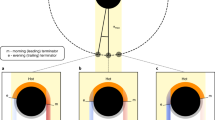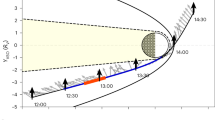Abstract
The ionized form of atomic oxygen (O+) is the dominant ion species at the altitude of maximum electron density in only one of the many ionospheres in our Solar System — Earth’s. This ionospheric composition would not be present if oxygenic photosynthesis was not an ongoing mechanism that continuously impacts the terrestrial atmosphere. We propose that dominance of ionospheric composition by O+ ions at the altitude of maximum electron density can be used to identify a planet in orbit around a solar-type star where global-scale biological activity is present. There is no absolute numerical value required for this suggestion of an atmospheric plasma biomarker — only the dominating presence of O+ ions at the altitude of peak electron density.
This is a preview of subscription content, access via your institution
Access options
Access Nature and 54 other Nature Portfolio journals
Get Nature+, our best-value online-access subscription
$29.99 / 30 days
cancel any time
Subscribe to this journal
Receive 12 digital issues and online access to articles
$119.00 per year
only $9.92 per issue
Buy this article
- Purchase on Springer Link
- Instant access to full article PDF
Prices may be subject to local taxes which are calculated during checkout

Similar content being viewed by others
References
Kasting, J. How to Find a Habitable Planet. (Princeton Univ. Press, Princeton, NJ, 2012).
Fahey, D. W. & Hegglin, M. I. Twenty Questions and Answers About the Ozone Layer: 2010 Update Q1 (World Meteorological Organization, 2011); http://go.nature.com/2Daamqn
Charbonneau, D., Brown, T., Noyes, R. & Gilliland, R. Detection of an extrasolar planet atmosphere. Astrophys. J. 568, 377–384 (2002).
Lammer, H. et al. Geophysical and atmospheric evolution of habitable planets. Astrobiology 10, 45–68 (2010).
Crossfield, I. Observations of exoplanet atmospheres. Publ. Astron. Soc. Pacif. 127, 941–960 (2015).
Schulze-Makuch, D. et al. A two-tiered approach to assessing the habitability of exoplanets. Astrobiology 11, 1041–1052 (2011).
Seager, S., Bains, W. & Petkowski, J. J. Toward a list of molecules as potential biosignature gases for the search of life on exoplanets and applications to terrestrial biochemistry. Astrobiology 16, 465–485 (2016).
Kreidberg, L. & Loeb, A. Prospects for characterizing the atmosphere of Proxima Centauri b. Astrophys. J. Lett. 832, L12 (2016).
Livio, M. & Silk, J. Where are they? Phys. Today 70, 50 (March, 2017).
Dressing, C. & Charbonneau, D. The occurrence of potentially habitable planets orbiting M dwarfs: Estimates from the full Kepler dataset and an empirical measurement of the detection sensitivity. Astrophys. J. 807, 45 (2015).
Garcia-Sage, K., Glocer, A., Drake, J., Gronoff, G. & Cohen, O. On the magnetic protection of the atmosphere of Proxima Centauri b. Astrophys. J. Lett. 844, L13 (2017).
Tian, F. Thermal escape from super Earth atmosphere in the habitable zones of M stars. Astrophys. J. 703, 905–909 (2009).
Tian, F. History of water loss and atmospheric O2 buildup on rocky exoplanets near M dwarfs. Earth Planet. Sci. Lett. 432, 126–132 (2015).
Luger, R. & Barnes, R. Extreme water loss and abiotic O2 buildup on planets throughout the habitable zone of M dwarfs. Astrobiology 15, 119–143 (2015).
Tian, F. & Ida, S. Water contents of Earth-mass planets around M dwarfs. Nat. Geosci. 8, 177–180 (2015).
Schaefer, L., Wordsworth, R., Berta-Thompson, Z. & Sasselov, D. Predictions of the atmospheric composition of GJ 1132b. Astrophys. J. 829, 63 (2016).
Chadney, J. et al. EUV-driven ionospheres and electron transport on extrasolar giant planets orbiting active stars. Astron. Astrophys. 587, A87 (2016).
Airapetian, V. A. et al. How hospitable are space weather affected habitable zone? The role of ion escape. Astrophys. J. Lett. 836, L3 (2017).
Gillon, M. et al. Seven temperate terrestrial planets around the nearby ultracool dwarf star TRAPPIST-1. Nature 542, 456–460 (2017).
Schunk, R. & Nagy, A. Ionospheres: Physics, Plasma Physics, and Chemistry 2nd ed, (Cambridge University Press, Cambridge, 2009).
Yung, Y. L. & DeMore, W. B. Photochemistry of Atmospheres (Oxford University Press, Oxford, 1998).
Mendillo, M. et al. Comparative Aeronomy: Molecular ionospheres at Earth and Mars. J. Geophys. Res. Space Phys. 121, 10269–10288 (2016).
Bougher, S. et al. Early MAVEN Deep Dip campaign reveals thermosphere and ionosphere variability. Science 350, aad0459 (2015).
Clancey, R. T. et al. Daily global mapping of Mars ozone column abundances with MARCI UV band imaging. Icarus 266, 112–133 (2016).
Catling, D. C. Astrobiology: A Very Short Introduction. (Oxford Univ. Press, Oxford, 2013).
Catling, D. C. & Kasting, J. Atmospheric Evolution on Inhabited and Lifeless Worlds Fig. 10.1. (Cambridge Univ. Press, Cambridge, 2017).
Walker, J. C. G. in The Natural Environment and the Biogeochemical Cycles 87–104 (Springer, Berlin, 1980).
Moore, L., Mendillo, M., Muller-Wödarg, I. & Murr, D. Modeling of global variations and ring shadowing in Saturn’s ionosphere. Icarus 172, 503–520 (2004).
Cui, J. et al. Diurnal variation of Titan’s ionosphere. J. Geophys. Res. Atmos. 114, A6 (2009).
Summers, M. E. & Strobel, D. F. Photochemistry and vertical transport of Io’s atmosphere and ionosphere. Icarus 120, 290–316 (1996).
Majeed, T. et al. The ionosphere of Triton. Geophys. Res. Lett. 17, 1721–1724 (1990).
Matta, M., Withers, P. & Mendillo, M. The composition of Mars’ topside ionosphere: Effects of hydrogen. J. Geophys. Res. 118, 2681–2693 (2013).
Owen, T. in Strategies for the Search for Life in the Universe 177–185 (Springer, Dordrecht, 1980).
Segura, A. et al. Ozone concentrations and ultraviolet fluxes on Earth-like planets around other stars. Astrobiology 3, 689–708 (2004).
Léger, A. et al. Is the presence of oxygen on an exoplanet a reliable biosignature? Astrobiology 11, 335–341 (2011).
Kasting, J. F. Habitable zones around low mass stars and the search for extraterrestrial life. Orig. Life Evol. Biosph. 27, 291–307 (1997).
Selsis, F., Despois, D. & Parisot, J.-P. Signatures of life on exoplanets: Can Darwin produce false positive detections? Astron. Astrophys. 388, 985–1003 (2002).
Withers, P. & Vogt, M. F. Occultations of astrophysical radio sources as probes of planetary environments: A case study of Jupiter and possible applications to exoplanets. Astrophys. J. 836, 114 (2017).
Grima, C., Blankenship, D. & Schroeder, D. Radar signal propagation through the ionosphere of Europa. Planet. Space Sci. 117, 421–428 (2015).
Robinson, T. D. et al. Detection of ocean glint and ozone absorption using LCROSS Earth observations. Astrophys. J. 787, 171 (2014).
Meier, R. Ultraviolet spectroscopy and remote sensing of the upper atmosphere. Space Sci. Rev. 58, 1–185 (1991).
Kumar, S., Chakrabarti, S., Paresce, F. & Bowyer, S. The O+ 834-A dayglow: Satellite observations and interpretation with a radiative transfer model. J. Geophys. Res. 88, 9271–9279 (1983).
Gruntman, M. & Fahr, H. Heliopause imaging in EUV: Oxygen O+ 83.4 nm resonance line emission. J. Geophys. Res. 105, 5189–5200 (2000).
Makela, J. J., Kelley, M. C., González, S. A., Aponte, N. & McCoy, R. P. Ionospheric topography maps using multi-wavelength all-sky images. J. Geophys. Res. 106, A12 (2001).
Mendillo, M., Spence, H. & Zalezak, S. Simulation studies of ionospheric airglow signatures of plasma depletions at the equator. J. Atmos. Terr. Phys. 47, 885–893 (1985).
Lugar, R. et al. The Pale Green Dot: A method to characterize Proxima Centauri b using exo-aurorae. Astrophys. J. 837, 63 (2017).
Rezac, L. et al. First detection of the 63 μm atomic oxygen line in the thermosphere of Mars with GREAT/SOFIA. Astron. Astrophys. 580, L10 (2015).
Pallé, E. et al. Earth’s transmission spectrum from lunar eclipse observations. Nature 459, 814–816 (2009).
Chen, R. H., Cravens, T. E. & Nagy, A. F. The martian ionosphere in light of the Viking observations. J. Geophys. Res. 83, A8 (1978).
Nagy, A., Cravens, T., Smith, S., Taylor, H. & Brinton, H. Model calculations of the dayside ionosphere of Venus: Ionic composition. J. Geophys. Res. 85, A13 (1980).
Hedin, A. E., Niemann, H. B., Kasprzak, W. T. & Seiff, A. Global empirical model of the Venus thermosphere. J. Geophys. Res. 88, 73–83 (1983).
Acknowledgements
This work was supported, in part, by an NSF INSPIRE grant to Boston University (Comparative Ionospheric Science: Earth, Solar System and Exoplanets; AST-1545581). We are pleased to acknowledge the thoughtful comments and suggestions by S. Chakrabarti (University of Massachusetts, Lowell). In addition, we thank the following colleagues at Boston University for helpful discussions dealing with early versions of the manuscript: J. Clarke, J. Semeter, M. Mayyasi, L. Moore, and J. Baumgardner and P. Muirhead; at the University of Massachusetts, Lowell: C. Mendillo, and S. Finn; and e-mail correspondents L. Rezac (Max-Planck Institute for Solar System Physics, Germany), J. Kasting (Penn State University), and B. Jakosky (University of Colorado, Boulder). J. Trovato helped with figure preparation.
Author information
Authors and Affiliations
Contributions
M.M. wrote the draft manuscript, providing its focus on the unique properties of Earth’s ionosphere and its observational methods; P.W. provided input on planetary atmospheres (Venus and Mars), and P.A.D. provided input on exoplanet atmospheres.
Corresponding author
Ethics declarations
Competing interests
The authors declare no competing financial interests.
Additional information
Publisher’s note: Springer Nature remains neutral with regard to jurisdictional claims in published maps and institutional affiliations.
Rights and permissions
About this article
Cite this article
Mendillo, M., Withers, P. & Dalba, P.A. Atomic oxygen ions as ionospheric biomarkers on exoplanets. Nat Astron 2, 287–291 (2018). https://doi.org/10.1038/s41550-017-0375-y
Received:
Accepted:
Published:
Issue Date:
DOI: https://doi.org/10.1038/s41550-017-0375-y
This article is cited by
-
Atmospheric carbon depletion as a tracer of water oceans and biomass on temperate terrestrial exoplanets
Nature Astronomy (2023)
-
High-resolution detection of neutral oxygen and non-LTE effects in the atmosphere of KELT-9b
Nature Astronomy (2021)



